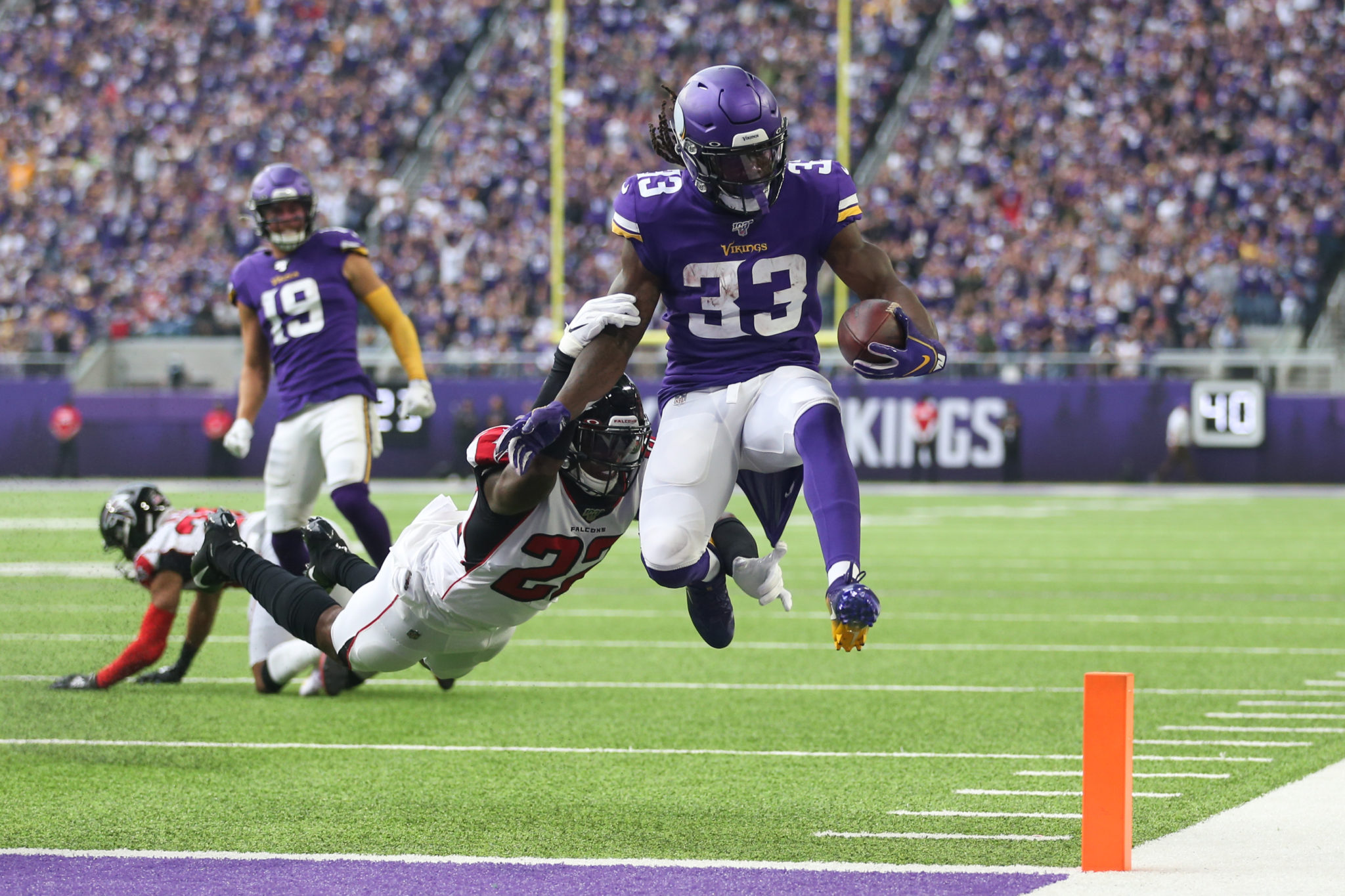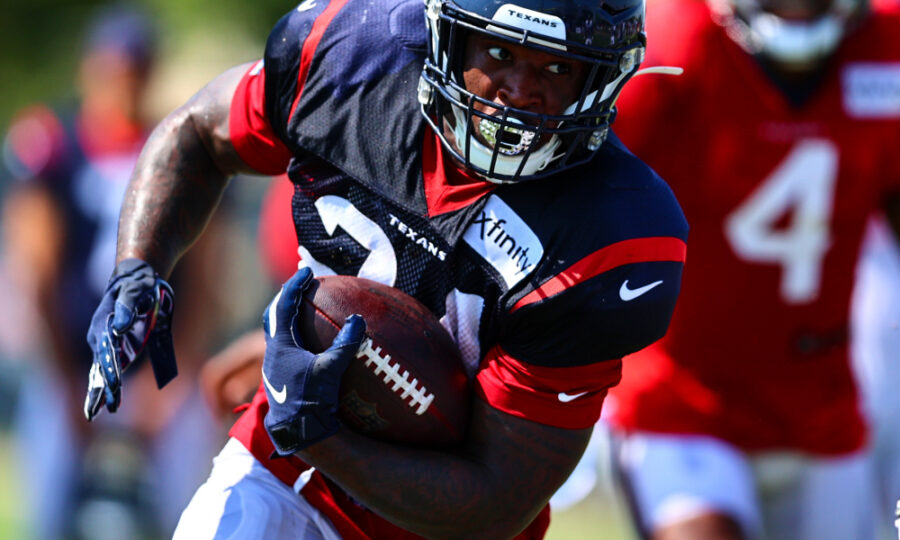NFL Game Scripts Week 4: Minnesota Vikings @ Houston Texans
After disappointing starts to the season, both the Houston Texans and Minnesota Vikings are looking to turn things around and secure their first win. Minnesota thought they did that in Week 3 as their offense finally got going, although they ultimately came up short and have this week been dealing with COVID testing, preventing them from practicing. Houston have had one of the toughest schedules in the league to start the season, and could see the Vikings’ disrupted week as a blessing.
Vikings Offense vs. Houston Defense
The Run Game

Minnesota had their best rushing game of the season in Week 3, as RB Dalvin Cook went for 181 yards and a TD. Although they will use backup Alexander Mattinson at times, and occasionally handoffs to WRs on end arounds and similar plays, these are mostly to give Cook a break and test defenses who are concentrating their players in the middle of the field. Cook is the engine room of the offense, running both between and outside of the tackles evenly.
During the first half, the Vikings will mostly have Cook run up the middle and to the outside, with the only extra blockers coming from the TE(s) that may be on the field for already. However, progressively they will integrate FB CJ Ham into the game to give Cook more space to run as the defense tires out. Additionally, with Ham on the field and either one or two TEs, the Vikings can begin disguising their runs more as the game enters the second half, using Cook on counters and using split zones with Ham running one direction and Cook the other. Minnesota, if they use 2TEs frequently in the first half, will use these to block for Cook on one side of the line. However, in the second half, the Vikings will start splitting the TEs to either side of the OL to further cloud the direction of their run plays.
Houston will try to move DE JJ Watt around the DL to prevent him being double-teamed, or to absorb extra blockers so that the LBs can attack the run more. The interior LBs in Zach Cunningham and Bernardrick McKinney should line up over the OGs and shoot the inside gaps, with the DL taking the B gaps, and DT Branden Dunn over Center. This will allow Houston to have Whitney Mercilus and Brennan Scarlett slightly wider, playing contain on Cook so that he is hit with a defender wherever he runs. With the Vikings using Ham or a TE to bring extra blockers for Cook, the Texans will need to move Watt to start absorbing the extra blockers, so that the other defenders aren’t forced to handle tougher assignments.
The Passing Game
The Vikings primarily use 2WR formations, as they are usually in 12 or 21 personnel. With rookie WR Justin Jefferson emerging as an outside threat in Week 3, it allows Adam Thielen to operate out of the slot and over the middle of the field more. To complement these WRs, the Vikings also use TEs on out routes and sometimes screens, as well as Cook on short underneath curls and swing routes to the outside.
Minnesota will have Jefferson and Thielen running both vertical and crossing routes throughout the game, leaving Bisi Johnson as the WR3 on some snaps to run short and intermediate comebacks and curls. The TEs also run 5-10 yard hitch routes downfield, using their size advantage to provide a bigger target, able to cut inside or outside based on what the defense is showing. These combinations will be used throughout the game, with Thielen also used on slants as the game progresses, so that the Texans have to keep at least one Safety over the middle of the field, leaving more space for the outside receiver.
The Texans 3-4 base defense suits the lack of WRs that Minnesota will put on the field. Safety Eric Murray will play closer to the line of scrimmage to defend against the TEs and/or Cook, leaving fellow Safety Justin Reid as the Cover 1 over the top. CB Bradley Roby could be used against either Jefferson to try and remove him as a passing option, although at times could also try and jam Thielen from the slot. Blitzing Murray or Roby also allows them to play inside more, as the Vikings could expect them to remain in coverage. Houston will want to play tight man coverage, but could struggle to defend the TEs and Cook if they get to the outside.
What should we expect to see on Sunday?
With a disrupted week, Minnesota can’t adjust their offense too much. They will lean heavily on Cook, and move both Jefferson and Thielen around to explore holes in the defense. As the game progresses the Vikings will use their TEs more as receivers and as blockers, while they will also use a third WR to test the Texans’ nickel DB. Houston can blitz with different players to pressure Cousins, and should aim to bracket Thielen often. Using their best CB, Roby, to try and shut out Jefferson where possible, may give their pass rush time to collapse the pocket.
Houston Offense vs.Vikings Defense
The Run Game

Houston’s inside zone scheme has had middling results this season, with their OGs struggling to creating running lanes and get the push needed for RB David Johnson to have space to work with. Occasionally they send him to the outside with either a FB or one of 2 TEs to help block, but rarely use toss or sweep plays to send Johnson even wider towards the sidelines. Against Minnesota, the Texans may have more success running through the middle as the Vikings have been struggling to close down these runs. For most of the game, the Texans will continue to run through the middle, with the majority of their outside runs still staying being the TEs.
As the game progresses, the Texans will increasingly leave a RB in the backfield as a blocker or late release for the passing game, especially when in shotgun. They rarely have both David Johnson and Duke Johnson on the field together, but may wish to explore more from these formations. From either the wishbone or shotgun, the Texans can use draw plays through the middle, setting up additional play action later in the game. Additionally, using 2 RBs, or 1 RB and a FB or TE, allows Houston to run split zone plays with the TE/FB pulling across from one side of the OL to the other. This will show the defense’s assignments and allowing for either extra blockers on one side, or counters to head towards the space that was just left. Into the second and third quarters, the Texans will aim to vary their run plays, but it will still be based on their inside running style.
Minnesota will try to force Houston to run to the outside, and should fill all gaps along the line with LBs. With Eric Kendricks taking one of the A gaps, and potentially an extra lineman as well in Jaleel Johnson and Hercules Mata’afa, the Vikings will try to leave little space for Johnson to run through. In turn, they can allow DE Yannick Ngakoue to contain one end, with one of their Safeties on the other end, forcing runs to avoid these players and stay on the interior. From here, even if the RB gets past the DL, the second Safety and LB should be sitting over the Tackles to slide inside or out to defend the run, based on whichever way Johnson tries to go.
The Passing Game
Houston’s aerial attack is primarily based on spacing and levels concepts, often featuring empty backfields. With Brandin Cooks as one outside receiver, the Texans use either Kenny Stills or Will Fuller as the other outside target, allowing a variation of Randall Cobb, Stills, Fuller and either TE Darren Fells and Jordan Akins to be lined up close to the line of scrimmage. Whichever side the slot receiver lines up on, they often send that receiver and the outside receiver on slants or inside routes, so that opposing LBs either drop back or come up to defend the pass, allowing QB DeShaun Watson to lead the open receiver underneath or further downfield. The TE runs a short out, curl or slant route towards the sideline, with the final receivers usually running downfield on a vertical route, and the other either running to the opposite sideline as the TE, or a short curl route over the middle.
As stated above, Houston tends to leave one player in as a blocker as the game progresses. In the first quarter, they usually have a TE as the blocker, with 3WRs and 1TE as the receiving options, hoping to spread the defense out across the field. Against Minnesota’s CBs, the Texans will target the outside receivers early on, so that the Vikings are forced to drop a Safety back in coverage on each side. From this, Houston should have space open underneath to their TE and slot WR, especially on out routes. As the second quarter and second half continue, Houston could look to use more bunch formations and disguise which player is running to the outside, so that the CBs have difficulty picking up which receiver to cover. This will then allow Fuller to get behind the CB, while Cooks and Cobb or Stills run crossing routes with the TE to give Watson easier completions.
Minnesota’s CBs have struggled over the first three weeks of the season, and will need Safety help all game. Safety Anthony Harris will help to bracket one of the WRs, most likely Cooks or Fuller, so that the Texans are forced to pass over the middle where there are more players in coverage. LB Eric Wilson should be matched up with the TE or RB. In the second half, especially if they are struggling against the pass, the Vikings may consider moving to Cover 4 zones instead, so that as the players space out across the field, there is a defender close to where they’ll be, potentially able to jump a route.
What should we expect to see on Sunday?
Houston will run the ball up the middle for the majority of the game, and spread the ball around the field through the air. Unless their OL can sustain blocks later in the game, Houston could shift to using an extra blocker, but will still be able to target the Vikings’ CBs deep. Minnesota need to help their CBs in any way possible, and will hope to flush the Texans’ rushing plays to the outside. Minnesota may choose to spread their defenders out later in the game if they aren’t getting stops, but it could expose them more on short passes.

